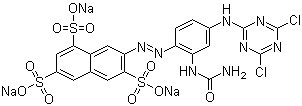
Image from chemblink.com
Advertisements
Advertisements
It is often quite difficult to determine the structures of dyes from the literature, because the manufacturers tend to try to keep this information a secret.
Some selected sources are given in the information below, suitable for purchases by hand dyers. (Chemical suppliers are too expensive, and most industrial sources require too large a minimum order size.)
Chemistry beginners should note that the drawings below are somewhat simplified. Most carbon atoms are indicated only as an angle where two lines, indicating covalent bonds, meet. If only three lines meet in one angle, there is also a hydrogen atom attached to that carbon. Carbon atoms may also be denoted with the letter C. Chlorine is Cl, Nitrogen is N, Oxygen is O, Sulfur is S, Copper is Cu, and Chromium is Cr.
Colour Index name: reactive yellow 86

Image from chemblink.com
Full chemical name: [1,3-benzenedisulfonic acid, 4-((5- aminocarbonyl-1-ethyl-1,6-dihydro-2-hydroxy-4-methyl-6-oxo-3- pyridinyl)azo)-6-(4,6-dichloro-1,3,5-triazin-2-yl)amino)-, disodium salt] (CAS Reg. No. 61951-86-8; also 70865-29-1)
Available wherever Procion MX type dyes are sold.
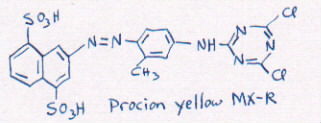
Available from Kraftkolour.
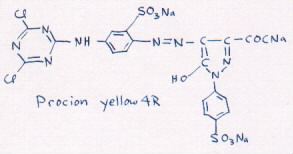
(no known source)
Colour Index Reactive Orange 1
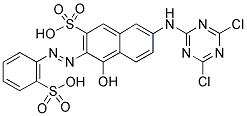
Sometimes available from Standard Dye or Classic Dye.
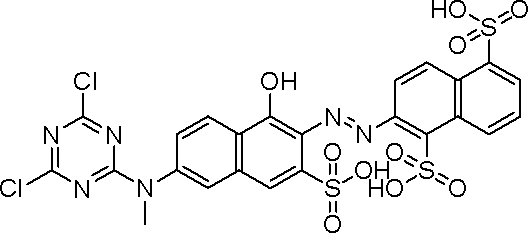
Colour Index name: reactive orange 4
Molecular Formula: C24H16Cl2N6O10S3; Molecular Weight: 715.527.
Full chemical name: 1,5-Naphthalenedisulfonic acid, 2-[[6-[(4,6-dichloro- 1,3,5-triazin-2-yl) methylamino]- 1-hydroxy-3-sulfo -2-naphthalenyl]azo]-, trisodium salt. (CAS 70616-90-9.)
Available wherever Procion MX type dyes are sold.
Colour Index name: reactive brown 23
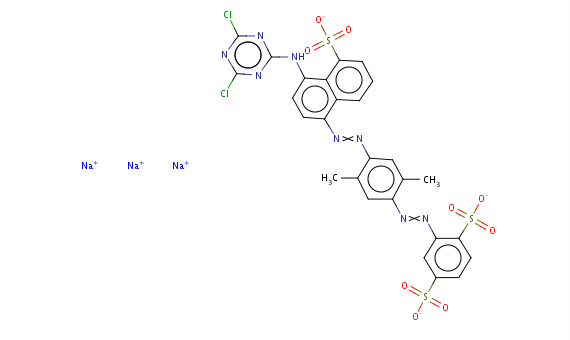
Image from MolPort.com
Alternative chemical name: 1,4-Benzenedisulfonic acid, 2-[[4-[[4-[(4,6-dichloro-1,3,5-triazin-2-yl)amino]- 5-sulfo-1-naphthalenyl]azo]- 2,5-dimethylphenyl]azo]-, trisodium salt. (CAS 68892-31-9.)

Full chemical name: Cuprate(3-),[2-[(4,6-dichloro-1,3,5-triazin-2-yl)amino]-5-hydroxy-6-[(2-hydroxy-5-sulfophenyl)azo]-1,7-naphthalenedisulfonato(5-)]-,trisodium (CAS 16038-15-6).
[Note correction: chemical name and CAS number formerly listed on this page for reactive red 6 had been accidentally duplicated from CI Reactive Red 1.]
Colour Index name: reactive red 6
Chemical formula: C19H7Cl2CuN6O11S3•3 Na
Molecular weight: 794.91
Copper content by weight (not including buffers, salts, etc., added to the powder during manufacture) would be just under 8%.
Sold by Colorado Wholesale Dyes as "14 Cherry".
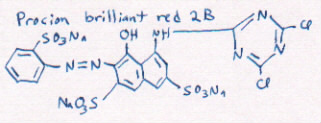
Colour Index name: reactive red 1
Full chemical name: 2,7-Naphthalenedisulfonic acid, 5-[(4,6-dichloro-1,3,5- triazin-2-yl)amino]-4-hydroxy- 3-[(2-sulfophenyl)azo]-, trisodium salt (CAS 17752-85-1).
(Sometimes available from Standard Dye or Classic Dye.)
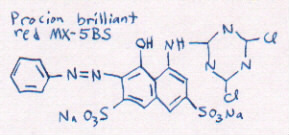
Colour Index name: reactive red 2; variously known as light red, mixing red, or clear red
Full chemical name: 2,7-Naphthalenedisulfonic acid, 5-[(4,6-dichloro- 1,3,5-triazin-2-yl)amino]- 4-hydroxy-3-(phenylazo)-, disodium salt
Empirical Formula (Hill Notation): C19H13Cl2N6NaO7S2, Formula Weight: 595.37, CAS Number: 17804-49-8; Dye content 40% (Sigma-Aldrich)
Available wherever Procion MX type dyes are sold.
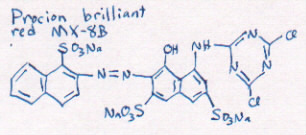
Colour Index name: reactive red 11; known everywhere as Fuchsia
Full chemical name: [5-((4,6-dichloro-1,3,5-triazin-2- yl)amino)-4-hydroxy-3-((1-sulfo-2-naphthalenyl)azo)-2, 7- naphthalenedisulfonic acid, trisodium salt] (CAS Reg. No. 12226-08-3)
Available wherever Procion MX type dyes are sold.
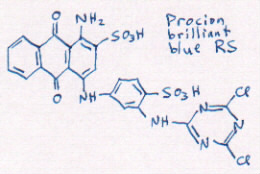
Colour Index name: reactive blue 4; known as Sky blue, Basic blue, or Clear blue
Full chemical name: [2-anthracenesulfonic acid, 1-amino-4-(3- ((4,6-dichloro-s-triazin-2-yl)amino)- 4-sulfoanilino)-9,10-dihydro-9,10- dioxo, disodium salt] (CAS Reg. No. 4499-01-8)
also given as "2-Anthracenesulfonic acid, 1-amino-4-[[3-[(4,6-dichloro-1,3,5-triazin-2-yl)amino]- 4-sulfophenyl]amino]-9,10-dihydro-9,10-dioxo-" (CAS 13324-20-4)
Empirical Formula (Hill Notation): C23H14Cl2N6O8S2, Formula Weight: 637.43, CAS Number: 13324-20-4
Available wherever Procion MX type dyes are sold.
Colour Index name: reactive blue 140
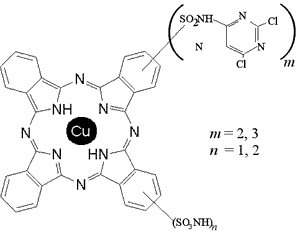 The structure of reactive blue 140 is not precisely known, because it is a heterogenous mixture of several closely related molecules. As indicated by the subscripts m and n in the picture, there may be one or two sulfonate groups on the phthalocyanine ring, there may be two or three dichlorotriazine sections per copper phthalocyanine, and the positions of these different items on the phthalocyanine ring are unknown and presumably random. In addition, this dye molecule, especially if kept in solution for several days, tends to 'stack up' to form aggregates of two or more molecules, causing the hue to shift to be more blue and less green. See "A Beautiful Blue: Procion Turquoise MX-G".
The structure of reactive blue 140 is not precisely known, because it is a heterogenous mixture of several closely related molecules. As indicated by the subscripts m and n in the picture, there may be one or two sulfonate groups on the phthalocyanine ring, there may be two or three dichlorotriazine sections per copper phthalocyanine, and the positions of these different items on the phthalocyanine ring are unknown and presumably random. In addition, this dye molecule, especially if kept in solution for several days, tends to 'stack up' to form aggregates of two or more molecules, causing the hue to shift to be more blue and less green. See "A Beautiful Blue: Procion Turquoise MX-G".
Available wherever Procion MX type dyes are sold.
Colour Index name: reactive orange 86
Full chemical name: (probably) 1,3,6-Naphthalenetrisulfonic acid, 7-[[2-[(aminocarbonyl)amino]- 4-[(4,6-dichloro-1,3,5- triazin-2-yl)amino]phenyl]azo]-, trisodium salt" (CAS 57359-00-9)
Available almost everywhere that Procion MX type dyes are sold.
Colour Index Reactive Brown 10
CAS 70788-63-5
Chromate(3-), bis[2-[[6-[(4,6-dichloro-1,3,5-triazin-2-yl) amino]-1-hydroxy-3-sulfo-2-naphthalenyl]azo]benzoato(3-)]-, disodium hydrogen.
Formerly an important componant in mixing black and neutral shades. Currently no known source.
(Thanks to Dan Snyder for this identification.)
Colour Index name: reactive blue 163
Full chemical name: triphenodioxazinedisulfonic acid, 6,13- dichloro-3, 10-bis((4-((4.6-dichloro-1,3,5-triazin-2-yl)amino) sulfophenyl)amino)-, tetrasodium salt (CAS Reg. No. 72847-56-4)
Available from ProChem, G&S Dye, Fibrecrafts, and Jacquard Products.
Colour Index Reactive Blue 109
CAS 70865-31-5
2,7-Naphthalenedisulfonic acid, 4-amino-6-[[5-[(4,6-dichloro-1,3,5-triazin-2-yl) amino]-2-sulfophenyl]azo]- 3-[(2,5-disulfophenyl)azo]-5-hydroxy-, pentasodium salt.
Available wherever Procion MX type dyes are sold.
(Thanks to Dan Snyder for this identification.)
Colour Index Reactive yellow 1
CAS 25489-31-0
Available from Synthesia in the Czech Republic and some other sources.
reactive yellow 22
CAS 12226-49-2
Available from ProChem.
reactive yellow 7
CAS 12226-46-9
Available from ProChem and Dharma.
reactive red 5
Available from Fibrecrafts in the UK.reactive violet 13
CAS 12270-87-0
Available from Kraftkolour (and also from ProChem if my guess about the identity of their Boysenberry Procion dye is correct).(often mislabeled violet MX-G, a meaningless dye code)
reactive violet 14
CAS 12270-88-1
Available from Jacquard Products, ProChem, and Dharma.
reactive blue 161
CAS 71872-77-0
Available from Aljo Mfg in New York and Quilt & Art in Germany.(sometimes sold as Navy MX-G)
reactive blue 9
CAS 12225-37-5
Sometimes available from Standard Dye.reactive blue 168
Available from ProChem and from Quilt and Art in Germany.reactive blue 1
Sometimes available from Aljo Mfg. or Standard Dye.CAS 129009-88-7 "2-Naphthalenesulfonic acid, 7-[(4,6-dichloro- 1,3,5-triazin-2-yl)amino]- 4-hydroxy- 3-[[4-[[2-(sulfooxy)ethyl]sulfonyl]phenyl]azo]-, disodium salt"
CAS 57583-69-4 "2,7-Naphthalenedisulfonic acid, 5-[(4,6-dichloro-1,3,5-triazin-2-yl)amino] -4-hydroxy-3-[(1-sulfo-2-naphthalenyl)azo]-, trisodium salt"
CAS 61433-40-7 "2,7-Naphthalenedisulfonic acid, 4-amino- 6-[[5-[(4,6-dichloro-1,3,5 -triazin -2-yl)amino]-2-sulfophenyl]azo]- 3-[(2,5-disulfophenyl)azo]-5-hydroxy-"
CAS 68992-03-0 "1,5-Naphthalenedisulfonic acid, 2-[[1-amino-7- [[5-[(4,6-dichloro- 1,3,5- triazin-2-yl)amino]- 2-sulfophenyl]azo]- 8-hydroxy-3,6-disulfo- 2-naphthalenyl]azo]-, pentasodium salt"
CAS 70776-20-4 "Benzenesulfonic acid, 5-[[4-[(4,6-dichloro-1,3,5-triazin-2-yl) methylamino]phenyl]azo]- 2-[2-(4-nitro-2-sulfophenyl)ethenyl]-, disodium salt"
CAS 83929-55-9 "Phenazinium, 3-[[4-[(4,6-dichloro-1,3,5-triazin-2-yl) amino]-2-sulfophenyl]amino]- 7-[ethyl[(3-sulfophenyl)methyl]amino]- 5-(4-methoxy-3-sulfophenyl)-, inner salt, disodium salt"
CAS 83949-27-3 "Phenazinium, 3-[[4-[(4,6-dichloro- 1,3,5-triazin-2-yl) amino]-2-sulfophenyl]amino]- 7-[ethyl[(3-sulfophenyl)methyl] amino]-5-(4-sulfophenyl)-, inner salt, disodium salt"
CAS 85946-19-6 "1H-Pyrazole-3-carboxylic acid, 4-[[5-[(4,6-dichloro-1,3,5- triazin-2-yl)amino]- 2-sulfophenyl]azo]- 4,5-dihydro-5-oxo-1-(4-sulfophenyl)-"
CAS 94133-47-8 "4,11-Triphenodioxazinedisulfonic acid, 6,13-dichloro- 3,10-bis[[4-[(4,6-dichloro-1,3,5-triazin-2-yl) amino]disulfophenyl]amino]-"
All of the pages on this site are copyright ©1998‑2025 Paula E. Burch, Ph.D.
Page created: January 9, 2000
Last updated: September 2, 2010
Downloaded: Tuesday, December 16,2025